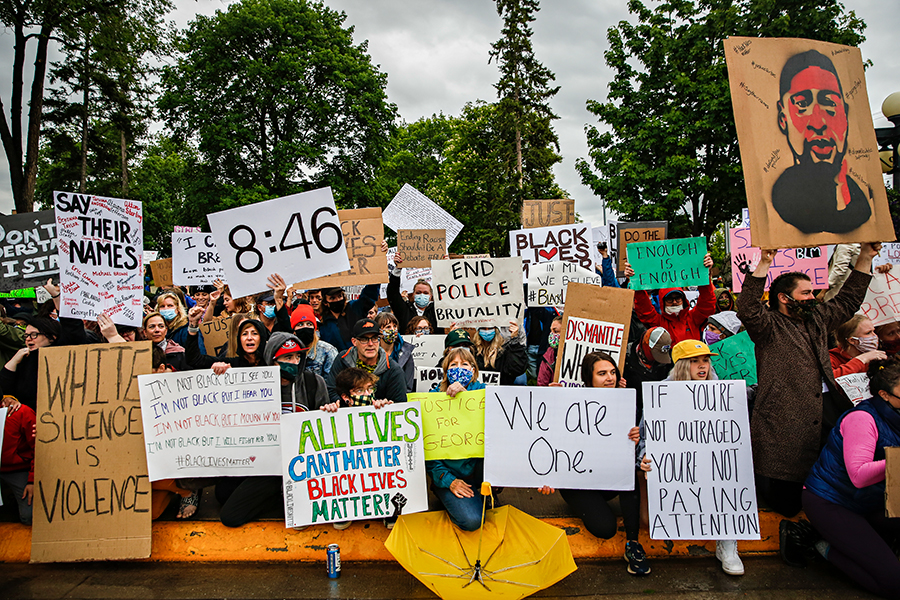Q & A: Local Reactions to the Jacob Blake Shooting
Ron Wilton and Samantha Francine discuss Black Lives Matter and racial relations in the U.S.
By Andy Viano
Back in May, the killing of George Floyd by police officers in Minneapolis spurred nationwide protests over police misconduct and renewed calls for major law enforcement reforms. That movement reached the Flathead Valley by early June, culminating in a Black Lives Matter protest of more than 1,000 people in Kalispell’s Depot Park on June 6.
More than two months later, Jacob Blake was shot seven times in the back by police officers in Kenosha, Wisconsin, setting off another round of protests around the country and more conversations about the role of law enforcement in American society.
To date, there have been no major protests in the Flathead Valley in support of the Black Lives Matter movement since Blake’s killing, but the Beacon spoke to two residents who were part of earlier demonstrations.
Ron Wilton, 65, is a business owner and longtime Kalispell resident who has raised three children here with his wife. The family attended the protest on June 6 but did not stay long in the presence of a heavily armed group of civilians who claimed they were at the protest to provide “protection.”
Samantha Francine, 28, grew up in Whitefish and was thrust into the national spotlight when she stared down a 51-year-old man who was screaming obscenities at peaceful protesters on a Whitefish street corner. She has since used her viral fame to act as a vocal advocate for people of color.
Their comments have been lightly edited for clarity.
Flathead Beacon: What was your initial reaction when you heard about Jacob Blake?
Ron Wilton: “I was appalled. My heart was broken once again. There’s a part of me, as a Black man, that has almost become desensitized to this. (It was) here we go again. I felt after the George Floyd protests that the peaceful demonstrations (and) the un-peaceful demonstrations, the riots, would begin some sort of conversation with our government, but it appears we’re the only ones talking. You have an administration that feels like systemic racism doesn’t exist. If systemic racism doesn’t exist, why do you have black people being shot by police?”
“My kids and I — my 21-year-old daughter (was) home — we’ve had these conversations, because you can’t turn on the TV (without seeing it). My kids and I have talked about what kind of scenario would create a situation where a police officer would shoot you seven times in the back. My kids are looking for answers, and as a dad I can’t give it to them.”
“My 12-year-old son is terrified of police. I think of Jacob Blake’s three young children who had to see their father get shot seven times. You feel like the world’s been flipped upside down.”
Samantha Francine: “The reactions are changing. After George Floyd the logical part of me wanted to think things would be going differently, but this is the first time my initial reaction was anger. Watching that video and reading what happened, what else are people of color supposed to do? It’s starting to become unlivable.”
“If you can’t see the divide, you’re choosing not to. I will keep advocating for people of color, but it’s getting to the point where it’s not safe.”
FB: At the Kenosha protests, a heavily armed 17-year-old killed two Black Lives Matters protestors. How did you respond to that shooting?
RW: “I couldn’t believe that happened. It blew me away, but it also scared me. All these individuals, who happen to be white, attend these protests with police stepping back. I don’t get it. You see this treatment of black people versus white people in America. Police and law enforcement do nothing. I don’t understand how these scenarios happen where there’s white folks and everything seems to be OK. And we get our heads kicked in.”
“As this goes on, I continue to reinforce to my children, and I don’t even have to say it anymore, that every day they take their lives into their own hands. You never know when someone who has hatred toward you may decide to act. You have to be aware that, to some people, our lives mean nothing.”
FB: On Aug. 26, the Milwaukee Bucks refused to play an NBA playoff game to demand action after Blake’s killing, a move later followed by the rest of the NBA, the entire WNBA and several teams in other sports. What did you think of their action?
SF: “I think it’s absolutely the right thing to do. This isn’t normal. To take a stand against brutality, it’s such a statement. I’m happy. I’m proud. People of color are getting worn out and (now) people of color in a position of power and influence are taking it seriously, and I’m so grateful. It’s very motivating.”
RW: “They’re trying to say, ‘Enough is enough.’ It wasn’t just out of sadness. They’re trying to make a statement that, at some point, enough is enough. They live this privileged life, but still they’re saying none of this makes a difference until black lives matter.”
FB: Are you hopeful for the future?
SF: “I am. I believe that a shift is coming and change is coming. Right now it seems bleak, but sometimes it’s dark before dawn. It’s hard to watch, but I’m very hopeful that this is the beginning of something beautiful.”
RW: “I hope and pray that (the NBA player protest) does have an impact, but I don’t really believe that it will. Because no matter how large the voice, how large the protest … you don’t have enough law enforcement people saying, ‘No more.’ This has to stop. We have to rethink the whole thing.”